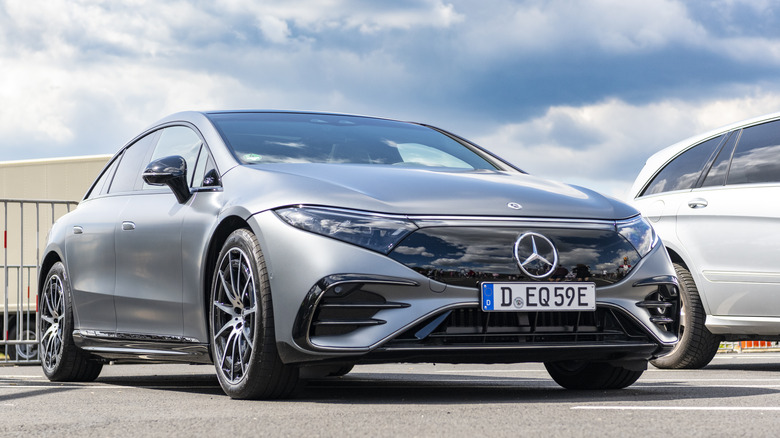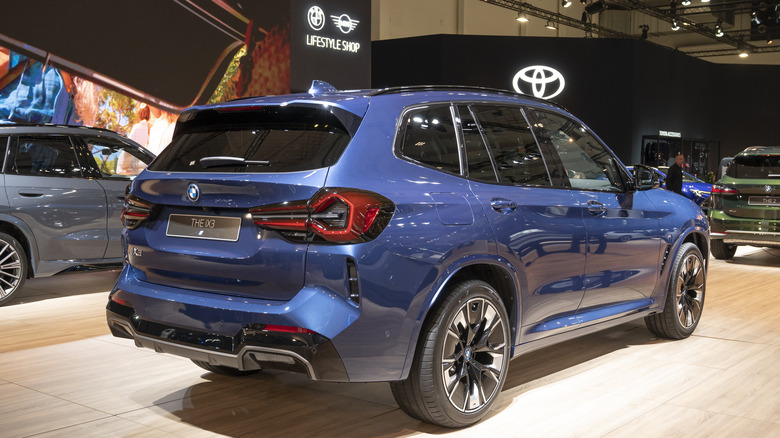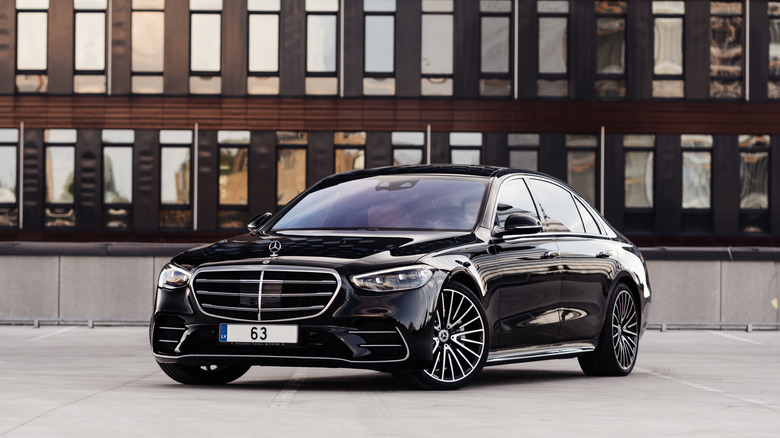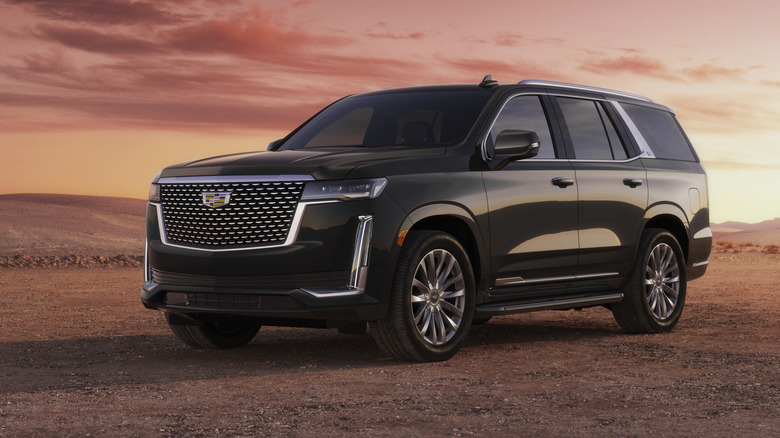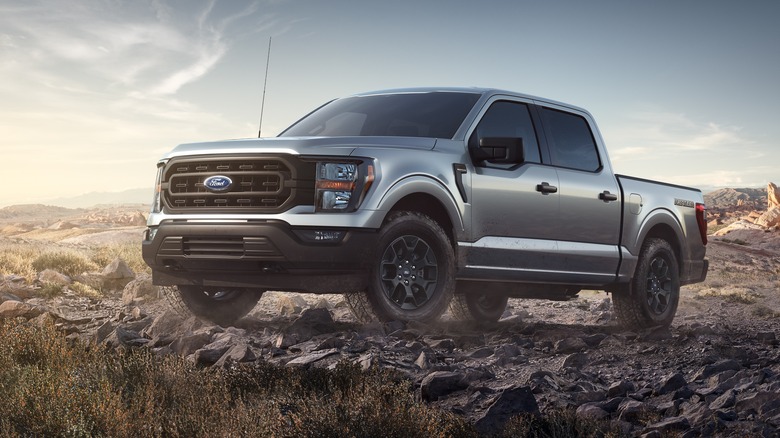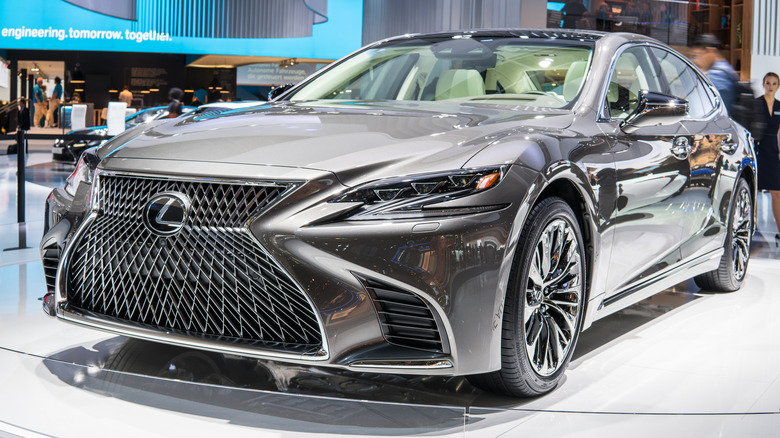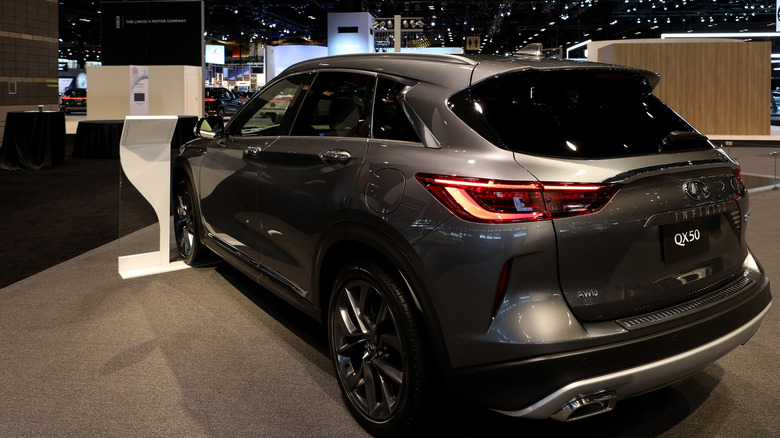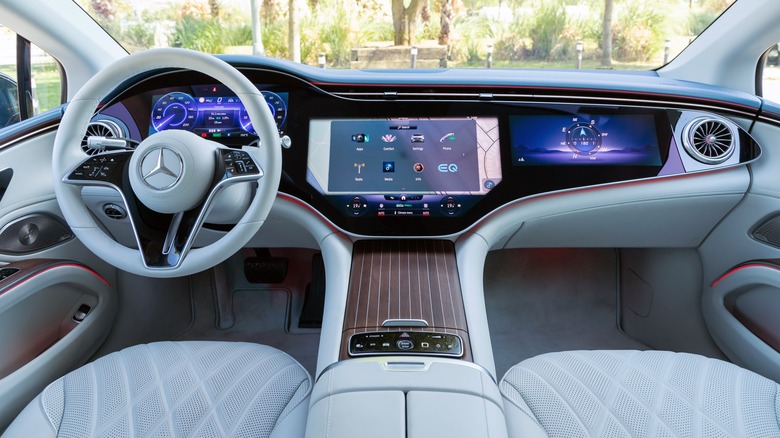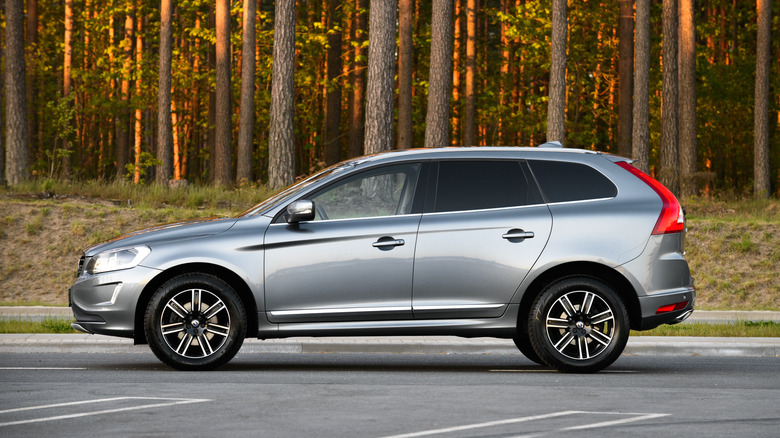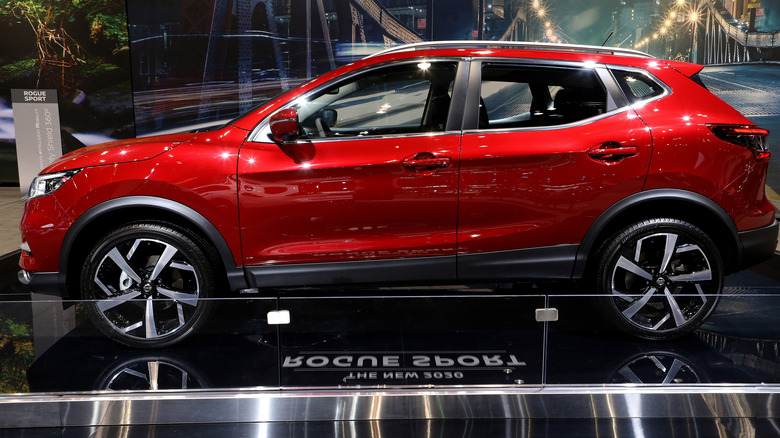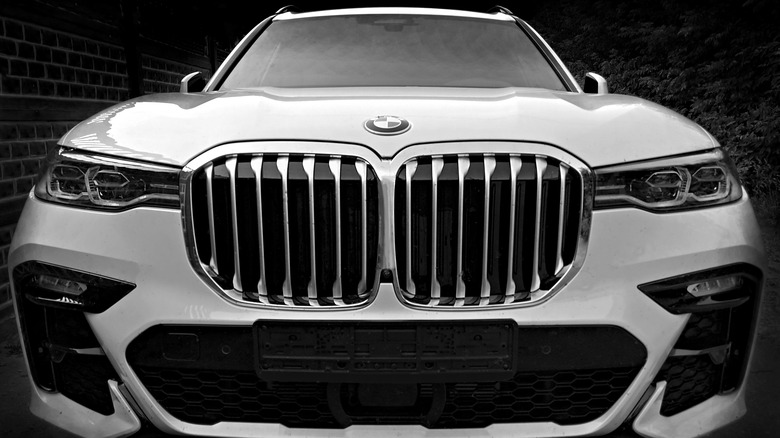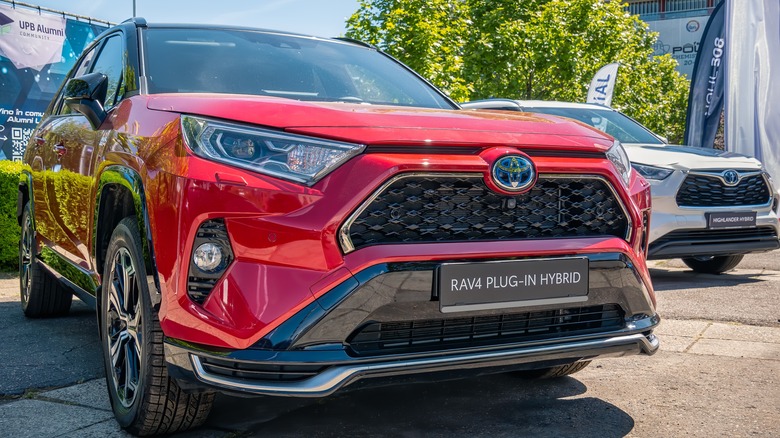The Best Driver Assistance Systems You Can Buy That Aren't Tesla Autopilot
Since the introduction of the Ford Model T in 1908 (via Ford), automobiles have enjoyed a steady evolution in all parts of their technology. We've seen developments in vehicle design and aerodynamics, transmission and differential systems, and even the energy sources used to power our cars. Now, it's clear that the driving experience is the next frontier of innovation, hence the goal of self-driving automobiles — cars that can perform one or more driving functions without the direct control of the driver.
It's also clear, though, that there's a stiff race among the companies invested in this driver-assistance tech. While Tesla dominates the automotive industry by both market share and valuation, it is neck deep in competition with other brands like Mercedes-Benz and General Motors to offer the most cutting-edge driver assistance. These and many other manufacturers work with the levels of autonomous driving outlined by the Society of Automotive Engineers, or SAE International: Level 0 – No Driving Automation, Level 1 – Driver Assistance, Level 2 – Partial Driving Automation, Level 3 – Conditional Driving Automation, Level 4 – High Driving Automation, and Level 5 – Full Driving Automation.
Admittedly, we still have a long way to go before Level 5 self-driving becomes a reality. So automobile companies have chosen to move through each level while ensuring a smooth driving experience and guaranteed safety. Combining these factors with other upsides of a vehicle such as design, cost, and range, it's easy to see how you might prefer a driver-assistance system that isn't Tesla Autopilot. Let's check them out.
BMW iX
BMW has not been sleeping on the driver-assistance movement. Its 2022-released BMW iX, an electric sports vehicle, reflects BMW's self-driving aspirations and accentuates all the advanced features of the vehicle. The car is built to sense and respond to everything that's going on around it, using a combination of five cameras that provide a clear view, five radar sensors for measuring object distances, and 12 ultrasonic sensors to ensure the detection of any obstacles and help avert accidents.
Even more, the Driver Assistant Professional — which is what BMW calls its advanced driver assistance system technology — comes with several other features to improve braking, acceleration, steering, handling, and overall control. These include Lane Guidance and Lane Keeping Assist to help you maintain your lane or safely change lanes on the road, Parking Assist which works with the cameras and ultrasonic sensors to park your vehicle, Forward Collision and Blind Spot Warnings to alert you of any proximal obstacles that could cause a collision, and Distance Control to keep the vehicle at an accident-free distance from other vehicles while driving. All of these come together to demonstrate BMW's ambitions to transform the driving experience.
Mercedes-Benz S-Class
Of course, Mercedes-Benz is another household name with a reputation for automotive quality, especially in the Mercedes-Benz S-Class. The luxury sedan already bears what the automaker calls the "Mercedes-Benz User Experience (MBUX)" (via Heycar). Soon, it will add the first SAE Level 3 self-driving technology to be approved globally.
DRIVE PILOT, Mercedes' self-driving suite works with several sensors inside and outside of the automobile including lidar sensors, cameras, and even microphones. These sensors help to enable a number of driverless features. There's Lane Change Assist, which actively changes lanes on the highway while monitoring the speed of vehicles behind and before the car. The S-Class also has the Distronic, or Active Distance Assist, to change the car's velocity and maintain a safe distance from other cars.
You can get Remote Parking Assist and Active Parking Assist, both of which allow for vehicle self-parking. Other features include Active Brake Assist and Active Emergency Stop Assist, focused on decelerating or stopping the vehicle if a collision is detected, Active Traffic Sign Assist and Active Speed Limit Assist, to detect traffic information and keep the driver within regulated speed limits, and many more. These features are further bolstered by the company's trademark Car-to-X Communication technology, which enables the S-Class to network with other similar vehicles and creates even safer driving conditions.
Cadillac Escalade
The American automobile manufacturer General Motors (GM) is also involved in the driver-assistance car race through the premium Cadillac brand, and the Cadillac Escalade provides a prime example of what GM is capable of. This full-size sports utility vehicle (SUV) is equipped with GM's Super Cruise driving assistant technology which, though currently still at SAE Level 2 automation, is so good that it rivals the self-driving tech in the vehicles of other industry giants including Tesla.
As one might expect, the capabilities of the Super Cruise technology are founded on an intelligent application of cameras and sensors on the vehicle, as well as a GPS system. Currently, Super Cruise works only on roads in the US and Canada that have been mapped by GM using lidar — but on these 200,000+ miles of roads, the functionality of Super Cruise is unmatched. Besides offering a smooth ride by damping the effects of road bumps and grooves, Super Cruise will let you drive completely hands-free on these mapped roads. Other features include lane centering, lane change assistance, and adaptive cruise control, to maintain the Escalade at a safe distance from the vehicles closest to it. Plus, with the new Trailering feature on the Escalade, it is now possible to tow a trailer on GM's mapped roads while using Super Cruise.
Ford F-150
GM is not the only American car company that's trying to cruise its way onto the top of the driver-assistance hierarchy. With the Blue Cruise on the Ford F-150, this automaker is proving that it can beat the best in the world.
Previously known as Active Drive Assist, Ford's Blue Cruise also deploys its high-level self-driving features only on pre-mapped roadways in North America, which currently exceed 130,000 miles according to the company. When on these roads, you get automatic steering, braking, and acceleration during the ride. At its core, Blue Cruise also features adaptive cruise control, speed limit recognition, and accurate self-parking capabilities made possible with Active Park Assist 2.0.
The driver assistance technology monitors whoever is in the driver's seat to ensure that they remain alert even when the vehicle is being driven hands-free. The company believes that until we attain a certain level of technological competence, such a feature remains necessary to guarantee the safety of drivers, passengers, property, and even the F-150 itself.
Lexus LS
Toyota, the automobile company that owns Lexus, has perhaps been late to the self-driving car party as it deployed its driver assistance technology on a Lexus vehicle for the first time in 2022. But this doesn't mean that the automaker came unprepared, nor did Toyota ship a suite of features that were below the industry standard. The Lexus LS 500h was the first Lexus car to feature the Lexus Teammate, an advanced driver assistance system that simply does not get enough credit for how effective it is.
The Lexus Teammate is currently rated at SAE Level 2. On the LS 500h, Lexus Teammate works with lidar sensors, radar sensors, ultrasonic sensors, and a 360-degree camera setup to provide an all-around view of the vehicle. Using these sensors and cameras, Teammate is capable of such functions as self-parking, automatic braking in cases of impending danger, lane centering and lane changing, adaptive cruise control to maintain safe car-to-car distances, and many others. There's also an infrared camera within the vehicle to monitor the driver and help them stay focused on the road.
Infiniti QX50
The Infiniti QX50 is also making a strong statement on the driver-assisted car leaderboard through the ProPILOT Assist. Developed by Infiniti's parent company Nissan, ProPILOT Assist works mainly with 360-degree cameras and radar sensors that provide a complete assessment of the vehicle's driving conditions relative to other vehicles and objects on the motorway. ProPILOT is capable of predicting how the QX50 should react to road conditions such as bumps and potholes, adjusting the vehicle's handling to minimize the effects of such conditions. Other smart features include automatic braking in emergency situations, intelligent detection of pedestrians and moving objects, automatic speed control and adjustment, notification of lane changes, recognition of traffic and road signs, collision alerts both in front of and behind the QX50, and adaptive cruise control.
In terms of driver and passenger safety, the ProPILOT Assist takes things a notch higher than both Toyota's Lexus Teammate and Ford's Blue Cruise. In this case, the driver has to keep their hands on the steering wheel even while ProPILOT utilizes automatic steering, acceleration, and braking controls. As Nissan and Infiniti collaborate to strengthen the algorithms for obstacle detection and collision avoidance on the QX50, there remains the goal of increasing the confidence level of the driver while self-driving features are in use and going completely hands-free. For now, though, this is still a major work in progress.
Mercedes-Benz EQS
The Mercedes-Benz EQS EV has an estimated range of 350 miles on a full charge and includes the DRIVE PILOT advanced driver assistance tech, which is the signature driver-assistance system of Mercedes-Benz. The DRIVE PILOT maintains the same features on the EQS as is available on the Mercedes-Benz S-Class, mainly working with sensors, cameras, and microphones to coordinate and control acceleration, braking, and steering automatically. Being rated at the SAE Level 3 of autonomous driving, the DRIVE PILOT can also take charge of the vehicle to optimize driving conditions using lane change and lane keeping, keeping to traffic regulations using traffic sign recognition and speed limits, and avert any accidents with the help of automatic emergency stops.
It's also worth noting that the DRIVE PILOT is currently configured to function only when the road and driving conditions support its operation. It cannot be used at night, it cannot be used above 37 miles per hour (60 kilometers per hour), nor can it operate in extreme weather conditions — as all of these cases require alertness and control by the driver. Moreover, while Mercedes-Benz looks to expand the operations of the DRIVE PILOT to other countries and continents, it only works on pre-mapped roads and highways for now.
Volvo XC60
For an automobile company that places such a high value on driving safety, it's a bit surprising that Swedish automaker Volvo would decide to tread the self-driving vehicle path. But what makes this development great is simple: with Volvo, car owners can be assured that the company has maintained this focus on safety while building its self-driving tech. The Volvo XC60, a midsize SUV has been a great vehicle for Volvo to demonstrate the potency of its Pilot Assist advanced driver assistance system.
Pilot Assist employs a range of radar sensors and cameras to develop real-time models of driving conditions and then automate certain features based on these models. Capable of operating at speeds up to 80 miles per hour, the core of the Pilot Assist system is its adaptive cruise control, by which it carefully manipulates the vehicle's speed to remain at a safe distance from other vehicles on all sides while driving. Pilot Assist is also capable of recognizing lane markings on a highway and then utilizing lane-centering algorithms to keep the XC60 within its lane. Other driver-assist tech features include driver monitoring to keep the driver alert, speed limit control, collision warnings, and automatic braking.
Nissan Rogue
Nissan integrated its driver-assistance tech into its best-selling automobile, the Nissan Rogue powered by the ProPILOT Assist. Presently rated at SAE Level 2, ProPILOT works with several sensors and cameras on the Nissan Rogue to automate some aspects of driving. Chief among these is its adaptive cruise control and lane maintenance assistance on the highway, traffic navigation assistance in stop-and-go conditions, ProPILOT-enabled parking that directs the driver with audiovisual cues during the parking process, obstacle detection and collision avoidance, automatic deceleration for corners and U-turns, automatic braking in emergency situations, and sonar detection of other cars on the road.
Unfortunately, you're not able to hand over full control to ProPILOT since the driver must keep their hands on the steering wheel to ensure their focus on the road. Hopefully, this is only a temporary limitation on the technology, but of course, safety has to be the priority here.
BMW X7
BMW's largest SUV by size, the BMW X7 also gets boosted with driver-assistance features. For this vehicle, BMW has deployed the Driving Assistance Professional Package and enabled its functions using cameras and sensors. Rated at the SAE Level 2 of autonomous driving, this package consists of such features as Extended Traffic Jam Assist for navigating the vehicle during stop-and-go traffic jams, Frontal Collision Warning, which alerts the driver of any obstacles in front of the vehicle, and City Collision Mitigation which helps drivers avoid other situations that could cause a collision.
Interestingly, BMW recently introduced Highway Assistant — which is normally found on BMW's 7 series — to the X7. At speeds up to 40 miles per hour, the vehicle can be driven hands-free. The Highway Assistant also keeps the driver-focused, using an in-vehicle camera that monitors the driver's head movement. Any distractions would cause the system to send a notification to the driver, and if they do not regain focus on the ride within a few seconds, the Highway Assistant is automatically disabled.
Toyota RAV4
The Toyota RAV4 presents a great opportunity for car owners who would love to explore driver-assistance features but can't afford a more luxurious vehicle. While the 2022-released Toyota RAV4 might not possess an array of specifications on the same level as the Mercedes-Benz luxury sedan, it definitely holds its own with regard to self-driving and safety features through the Toyota Safety Sense 2.0.
The Safety Sense 2.0 hosts several smart systems including Smart Stop Technology which halts the RAV4 if a possible collision is detected, Brake Assist to automate deceleration and braking in cases of emergency, Parking Assist, Traction Control to optimize vehicle handling and stability, Dynamic Cruise Control which works with the radar sensors, and Lane Departure and Tracing Controls.
It would seem that Toyota aims to develop different driver-assistance tech suites for its Toyota and Lexus vehicles, so we might not see the Lexus Teammate on Toyota cars. But it's expected that both systems will benefit each other, even as Toyota aims to launch fully autonomous driving by 2025. We know that research in this area has been active within Toyota for a while now, so we can't wait to see what that's like.
